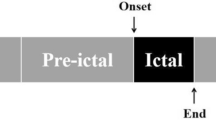Abstract
Objective
Our previous work suggested that sensitivity of hippocampal neurons is changed in process of epileptic activities, and closely parallel to the dynamic characteristic of epileptic activity of the neurons. This study investigated the sensitivity of epileptic brain to vagal nerve stimulation (VNS) in epileptic process.
Methods
Epileptic model was evoked by penicillin. Left vagal nerves were stimulated to inhibit the seizures induced by penicillin. The electrocorticography (ECoG) and electromyography (EMG) were recorded to analyze inhibiting effect of VNS in epileptic process.
Results
It was found that VNS could inhibit the seizures caused by penicillin, and the inhibiting effect of VNS to seizures increased as the vagal nerve stimulating time prolonged. It was also found that the inhibiting effect of VNS to seizures decreased in epileptic process.
Conclusion
The results suggested that the sensitivity of epileptic brain to VNS was different in epileptic process. The inhibiting effect of VNS to seizure decreased as the development of seizures.
摘要
目的
我们以前的研究发现大鼠海马神经元对刺激的敏感性在癫痫发作过程中是变化的, 并且与神经电活动的非线性动力学特征密切相关。 本研究观察在癫痫发作过程中迷走神经刺激(vagal nerve stimulation, VNS)对癫痫的抑制作用。
方法
在青霉素诱导的大鼠癫痫模型上, 通过记录皮层脑电图和下肢肌电图观察癫痫发作情况, 电刺激左侧颈部迷走神经, 观察 VNS 对癫痫的抑制作用。
结果
VNS 对癫痫活动有明显的抑制作用, 其抑制作用随着刺激时间的延长而增加; 同时发现 VNS 对癫痫的抑制作用在癫痫发作过程是不同的, 癫痫发作开始阶段 VNS 的抑制作用较强, 随着癫痫发作的发展, 其抑制作用逐渐减弱。
结论
大鼠癫痫发作过程中大脑对 VNS 的敏感性是不同的, 随着癫痫的发展, VNS 对癫痫的抑制作用逐渐减弱。
Similar content being viewed by others
References
Casazza M, Avanzini G, Ferroli P, Villani F, Broggi G. Vagal nerve stimulation: relationship between outcome and electroclinical seizure pattern. Seizure 2006, 15: 198–207.
Westbrook GL. Seizures and epilepsy. In: Kandel ER, Schwartz JH, Jessell TM, eds. Principles of Neural Science, 4th ed. New York: McGraw-Hill, 2000, 910.
Koch C, Laurent G. Complexity and the nervous system, Science 1999, 284: 96–98.
Rosso OA, Martin MT, Figliola A, Keller K, Plastino A. EEG analysis using wavelet-based information tools. J Neurosci Methods 2006, 153: 163–182.
Andrzejak RG, Widman G, Lehnertz K, Rieke C, David P, Elger CE. The epileptic process as nonlinear deterministic dynamics in a stochastic environment: an evaluation on mesial temporal lobe epilepsy. Epilepsy Res 2001, 44: 129–140.
Yambe T, Asano E, Mauyama S, Shiraishi Y, Shibata M, Sekine K, et al. Chaos analysis of electro encephalography and control of seizure attack of epilepsy patients. Biomed Pharmacother 2005, 59Suppl 1: S236–S238.
Iasemidis LD, Shiau DS, Pardalos PM, Chaovalitwongse W, Narayanan K, Prasad A, et al. Long-term prospective on-line real-time seizure prediction. Clin Neurophysiol 2005, 116: 532–544.
Hu SJ, Yang HJ, Jian Z, Long KP, Duan YB, Wan YH, et al. Adrenergic sensitivity of neurons with non-periodic firing activity in rat injured dorsal root ganglion. Neuroscience 2000, 101: 689–698.
Yang HJ, Hu SJ, Han S, Liu GP, Xie Y, Xu JX. Relation between responsiveness to neurotransmitters and complexity of epileptiform activity in rat hippocampal CA1 neurons. Epilepsia 2002, 43: 1330–1336.
Feng Y, Chao DM, Li WM, Cao YX, Wang YQ, Wu GC. Inhibition of nociceptin/orphanin FQ on penicillin-induced seizures in rats. Brain Res 2004, 1020: 214–219.
Groves DA, Bowman EM, Brown VJ. Recordings from the rat locus coeruleus during acute vagal nerve stimulation in the anaesthetised rat. Neurosci Lett 2005, 379: 174–179.
Wheless JW, Baumgartner J. Vagus nerve stimulation therapy. Drugs Today (Barc) 2004, 40: 501–515.
Elger CE, Widman G, Andrzejak R, Arnhold J, David P, Lehnertz K. Nonlinear EEG analysis and its potential role in epileptology. Epilepsia 2000, 41Suppl 3: S34–S38.
Yang HJ, Hu SJ, Gong PL, Duan JH. The sensitivity of neurons with non-periodic activity to sympathetic stimulation in rat injured dorsal root ganglion. Neurosci Bull 2006, 22: 14–20.
Chaovalitwongse W, Iasemidis LD, Pardalos PM, Carney PR, Shiau DS, Sackellares JC. Performance of a seizure warning algorithm based on the dynamics of intracranial EEG. Epilepsy Res 2005, 64: 93–113.
Adeli H, Ghosh-Dastidar S, Dadmehr N. A wavelet-chaos methodology for analysis of EEGs and EEG subbands to detect seizure and epilepsy. IEEE Trans Biomed Eng 2007, 54: 205–211.
Author information
Authors and Affiliations
Corresponding author
Rights and permissions
About this article
Cite this article
Yang, HJ., Peng, KR., Hu, SJ. et al. Inhibiting effect of vagal nerve stimulation to seizures in epileptic process of rats. Neurosci. Bull. 23, 336–340 (2007). https://doi.org/10.1007/s12264-007-0050-x
Received:
Published:
Issue Date:
DOI: https://doi.org/10.1007/s12264-007-0050-x




